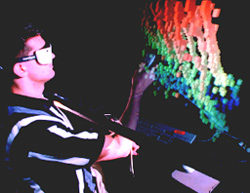TeraScope Demo at SC’02 Previews OptIPuter Capabilities
November 16th, 2002 - November 22nd, 2002
Categories: Data Mining, Devices, Networking, Tele-Immersion, Visualization

About
Among the hot buzzwords being heard on the SC2002 show floor this week in Baltimore, those prefixed by Lambda are increasingly ubiquitous.
In networking parlance, Lambda refers to lightpaths, or more broadly, optically-enabled technology, tools and protocols. A variety of Lambda-enabled technologies are behind the University of Illinois at Chicago (UIC) Electronic Visualization Laboratory’s TeraScope demonstration, now going on in the Project DataSpace booth.
TeraScope is a set of information visualization tools to query, correlate and visualize terabytes of data - in this case, atmospheric data collected and maintained by the National Center for Atmospheric Research’s (NCAR) Community Climate Model (CCM3). It also explores one aspect of the emerging OptIPuter architecture called LambdaRAM, which harnesses all the memory on a cluster to provide a high-speed data cache to minimize the impact of latency over long distance optical networks.
The National Science Foundation-sponsored OptIPuter is a powerfully distributed infrastructure that tightly couples computational, storage and visualization resources over parallel optical networks using the Internet Protocol (IP) communication mechanism. In short, the OptIPuter paradigm treats distributed computer clusters as a single giant computer where the dedicated optical network acts as the system bus.
TeraScope is a framework and suite of tools for interactively browsing and visualizing large terascale datasets. Terascope’s goal is to provide visualization tools that allow scientists to generate meaningful visual summaries (TeraMaps) of terabytes of data, from which relevant subsets (TeraSnaps) can be visualized on modest systems. The rapid derivation of TeraScope’s visual summaries is what requires the caching techniques of LambdaRAM. The goal is to let scientists fluidly work with massive data sets as interactively as one would work with a spreadsheet on a laptop, said EVL Senior Research Scientist Jason Leigh.
In the OptIPuter model, computer clusters are referred to as LambdaNodes because they are connected by multiples of light paths in an optical network. Each computer in a LambdaNode is referred to as a nodule, and collections of LambdaNodes form a LambdaGrid. The data LambdaNodes used in the TeraScope project consist of UIC’s Laboratory for Advanced Computing’s (LAC) Project Data Space clusters.
Project Data Space provides the software infrastructure to allow researchers to publish data on the Web in the same way they would publish documents, using a transport protocol (DSTP) analogous to HTTP for the Web. Data retrieved from DSTP servers are streamed at the maximum capacity of the network using an aggressive data transmission scheme called SABUL (Simple Available Bandwidth Utilization Library) which is based on enhancing UDP to provide reliable data transmission, while overcoming the bottlenecks of TCP.
LambdaRAM is based on the concept of Network Memory, or NetRAM. Prior work in NetRAM has focused on local or system area networks, simply because there has never been sufficient bandwidth over a wide-area network to carry data from memory to memory at rates that are close to memory access rates. The unique difference on the OptIPuter is that the high-speed optical network that interconnects its components makes NetRAM over wide areas practical.
The OptIPuter is a five-year, $13.5 million project funded by the National Science Foundation. It will enable scientists who are generating massive amounts of data to interactively visualize, analyze, and correlate their data from multiple storage sites connected to optical networks. Led by Cal-(IT)2 Director Larry Smarr, the project is a joint venture of the University of California, San Diego (UCSD) and the University of Illinois at Chicago (UIC). They will lead the research team, in partnership with researchers at Northwestern University, San Diego State University, the Information Sciences Institute at the University of Southern California, and University of California-Irvine [a partner of UCSD in Cal-(IT)2].
Co-PIs on the project are UCSD’s Mark Ellisman and SDSC’s Philip Papadopoulos, and UIC’s Thomas A. DeFanti, Jason Leigh, and Project Manger Maxine Brown.
For more information on the OptIPuter project see: www.evl.uic.edu/cavern/optiputer